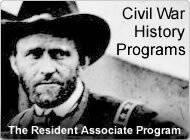
America's Game!
The Smithsonian Associates Civil War E-Mail Newsletter, Volume 7, Number 7
Baseball has deep roots in Washington, DC. Edmund F. French, a clerk in the Treasury Department, compiled the organizational charter of the Washington National Base-ball Club in 1859. The Nationals played in a field near Capitol Hill known as Swampdoodle Grounds, about where Union Station now stands.
Alexander Cartwright codified the first rules of the game. By the end of the Civil War, ballplayers were so skilled at the sport that not only was President Andrew Johnson rooting them on, but they also traveled south to the Capital of the Confederacy itself. In addition to Richmond, Virginia, they traveled as far north as Albany, New York, where they beat some of the top ballplayers in the country.
A rivalry developed when Nicholas H. Young formed a second professional team within the city limits. Young learned the game as a soldier during the Civil War. Afterwards, he played on the field with the Washington Nationals, organized the Washington Olympics ball club, and also ran a school for umpires within the city. Nick Young was later credited with originating the National League of Professional Ballplayers, the very same major league that exists to this day! With the arrival of Young's rival Olympics, DC baseball teams like the Capitals, Empires, Interiors, Unions, and Jeffersons, sprung up throughout the city and its suburbs.
By the end of the 1870s and into the 1900s, inter-city rivalries flourished while the Nationals and Olympics played teams from all over the northeast, consistently drawing "kranks"--fanatics, or as they became popularly known, fans. By the end of the century, Washington DC-based teams were part of the short-lived Union and American Association Leagues and, for a brief period for time, the Nationals even joined Nick Young's own National League.
In spite of the team's name change from the Washington National's to the Washington Senators in 1901, they always were known as the Nationals to the hometown folks, even up until the year they deserted Washington in 1971. But it wasn't true that our home team was "first in war, first in peace, and last in the American League."
The fact of the matter is that the Nationals/Senators won the World Series in 1924, and had many record-breaking players on their roster. This included legends the likes of Connie Mack, "Grasshopper" Jim Whitney, "Honest John" Morrill, "Scrappy" Bill Joyce, and William Hoy, a hearing-impaired player who is credited with developing the first baseball hand signals.
We can't forget two more: The first is "Big Train" Walter Johnson, who played his entire career with the Senators and is rated among the top athletes of the 20th Century. The second is the unforgettable first baseman Joe Judge, who inspired the play, Damn Yankees. His family claims when he watched games as a retired player, he could be heard to say, "Damn Senators!" whenever the team needed his help!
Damned or not, they once again are our Washington Nationals! Go Nats!

